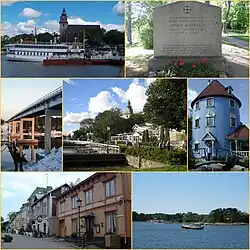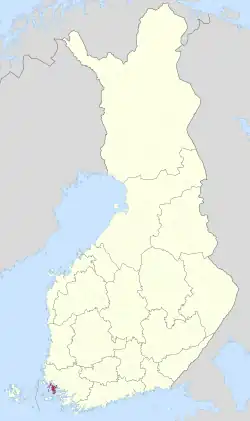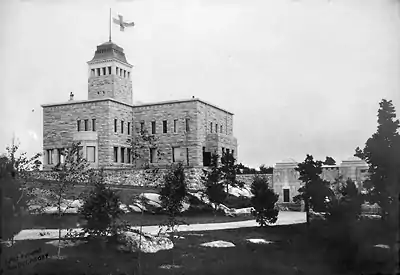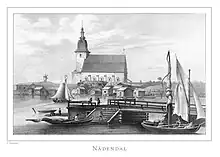Naantali
Naantali (Finnish pronunciation: [ˈnɑːntɑli]; Swedish: Nådendal) is a town in Southwest Finland, and, as a resort town during the summer, an important centre of tourism in the country.[6][7][8] The municipality has a population of 19,958 (26 October 2023),[3] and is located 14 kilometres (8.7 mi) west of Turku.
Naantali
Nådendal | |
|---|---|
City | |
| Naantalin kaupunki Nådendals stad | |
 Images, from top, left to right: Naantali’s medieval stone church and SS Ukkopekka, Jöns Budde statue, Särkänsalmi bridge, the guest harbour and Old Town of Naantali, Moomin's haus in Moomin World (Muumimaailma), Naantali Old Town and Archipelago of Naantali. | |
 Coat of arms | |
| Nickname: The Valley of Grace[1] | |
 Location of Naantali in Finland | |
| Coordinates: 60°28′N 022°02′E | |
| Country | |
| Region | Southwest Finland |
| Sub-region | Turku sub-region |
| Charter | 1443 |
| Government | |
| • Town manager | Jouni Mutanen |
| Area (2018-01-01)[2] | |
| • Total | 687.98 km2 (265.63 sq mi) |
| • Land | 311.50 km2 (120.27 sq mi) |
| • Water | 376.51 km2 (145.37 sq mi) |
| • Rank | 231st largest in Finland |
| Population (2023-10-26)[3] | |
| • Total | 19,958 |
| • Rank | 54th largest in Finland |
| • Density | 64.07/km2 (165.9/sq mi) |
| • | 18 800 |
| Population by native language | |
| • Finnish | 95.3% (official) |
| • Swedish | 1.4% |
| • Others | 3.3% |
| Population by age | |
| • 0 to 14 | 14.8% |
| • 15 to 64 | 58.8% |
| • 65 or older | 26.3% |
| Time zone | UTC+02:00 (EET) |
| • Summer (DST) | UTC+03:00 (EEST) |
| Website | www.naantali.fi |
The town has a land area of 311.50 square kilometres (120.27 sq mi).[2] Most of this area is located on the islands, but the majority of the population lives on the mainland. Most of the islands are covered with forest and farmland, while the mainland consists chiefly of residential areas.
History
One of the oldest towns in Finland, Naantali was founded around the medieval Brigittine convent Vallis gratiae (or Nådendal Abbey), the church of which still dominates its skyline. The charter was signed by King Christopher of Bavaria, the then ruler of Finland, in 1443. The convent got trading rights and other privileges, and the town around it began to grow. It also became an important destination for pilgrimage.
In the 16th century, as Catholicism gave way to Protestantism as the official religion of Finland, the convent was closed, and the town plunged into a depression. This lasted until the mid-18th century, when the town got a tollgate and a customs chamber. In the two centuries of economic stagnation before that the town had become famous for its knitted stockings, a craft carried on from the times of the convent.
The year 1863 saw the founding of the spa at Cape Kalevanniemi, which raised the town's status as a holiday venue. In 1922, the Kultaranta estate on Luonnonmaa was made the official summer residence for the President of the Republic, after Finland had gained its independence five years earlier.
The municipalities of Merimasku, Rymättylä and Velkua were consolidated with Naantali on January 1, 2009.
The per capita tax income of the town is the second highest of all towns in Finland, and the highest in the province of Southwest Finland.
Name
The name Naantali is the fennicised version of the Swedish name of the town, Nådendal. The Swedish name was given as a direct translation from the Latin Vallis Gratiae which literally means "The Valley of Grace".[1]
Tourism and points of interest
The proximity of both Turku, the region's administrative centre and largest city, and of the archipelago both contribute to the area's popularity with tourists.
Other points of interest in the city include Moomin World, a theme park on the island of Kailo, and Naantali’s medieval convent stone church. The area also includes the official summer residence of the President of Finland, the Kultaranta estate which is located on Luonnonmaa.
The archipelago sea boat traffic is handled by S/S Ukkopekka. Old steamship cruise Naantali-Turku-Naantali.
Naantali hosts an international music festival every June, and the traditional Sleepyhead Day carnival in July.
Culture
Every July 27, Naantali celebrates the National Sleepy Head Day (Finnish: Unikeonpäivä; Swedish: Sjusovardagen). The old tradition is to throw a chosen "sleepy head", an usually Finnish celebrity, in the sea from the city's port at 8 a.m. The identity of the sleeper is kept secret until the event. People who are chosen have usually done something to the benefit of the city.[9][10][11][12]
Other industries
In addition to tourism, the city's main industries are electricity production, oil refining, manufacturing, and services. The Port of Naantali is the third largest in Finland in terms of goods traffic, and the city is home to a power plant and an oil refinery owned by the government-controlled company Fortum and Neste.
International relations
Notable people
- Kaarlo Heinonen (1878–1944)
- Teppo Rastio (born 1934)
- Pekka Siitoin (1944–2003)
- Keijo Virtanen (born 1945)
- Ilkka Kantola (born 1957)
- Lauri Heikkilä (born 1957)
- Jukka Vilander (born 1962)
- Cristal Snow (born 1975)
Gallery
 Naantali Church, one of the oldest monuments in Finland
Naantali Church, one of the oldest monuments in Finland Kultaranta Castle residence of the President of Finland, in 1920
Kultaranta Castle residence of the President of Finland, in 1920 Steamship S/S Ukkopekka
Steamship S/S Ukkopekka Moomin World is one of the most popular theme parks of Northern Europe.
Moomin World is one of the most popular theme parks of Northern Europe. Street view in the summertime.
Street view in the summertime. Naantali old town and harbour
Naantali old town and harbour Litograph of Nådendal from mid-19th century, published in Finland framstäldt i teckningar by Zacharias Topelius.
Litograph of Nådendal from mid-19th century, published in Finland framstäldt i teckningar by Zacharias Topelius. Steel engraving of Nådendal from mid-19th century, published in En resa i Finland by Zacharias Topelius
Steel engraving of Nådendal from mid-19th century, published in En resa i Finland by Zacharias Topelius
See also
References
- "Keskiaika - Suomen kaupungit keskiajalla". Katajala.net. Retrieved 2013-12-28.
- "Area of Finnish Municipalities 1.1.2018" (PDF). National Land Survey of Finland. Retrieved 30 January 2018.
- "Preliminary population statistics 2023, September". StatFin. Statistics Finland. Retrieved 26 October 2023.
- "Demographic Structure by area as of 31 December 2022". Statistics Finland's PX-Web databases. Statistics Finland. Retrieved 6 September 2023.
- "Population according to age (1-year) and sex by area and the regional division of each statistical reference year, 2003–2020". StatFin. Statistics Finland. Retrieved 2 May 2021.
- Naantali: the sunniest Finnish city to visit in summer – Itinari
- A WALK THROUGH NAANTALI, THE SUNNIEST TOWN IN FINLAND! – Live Now, Dream Later
- Naantali – Discovering Finland
- People in Finland are celebrating National Sleepy Head Day and it’s awesome - Metro.co.uk
- Unikeonpäivä: Sleepy Head Day in Finland - Big in Finland
- Sleepyhead Day - YLE
- National Sleepy Head Day: Church organist doused in Naantali - YLE
External links
- Town of Naantali – Official website
- Naantali Tourist Information Ltd
 Naantali travel guide from Wikivoyage
Naantali travel guide from Wikivoyage- Naantali Spa Hotel
- Moomin World
- VG-62
